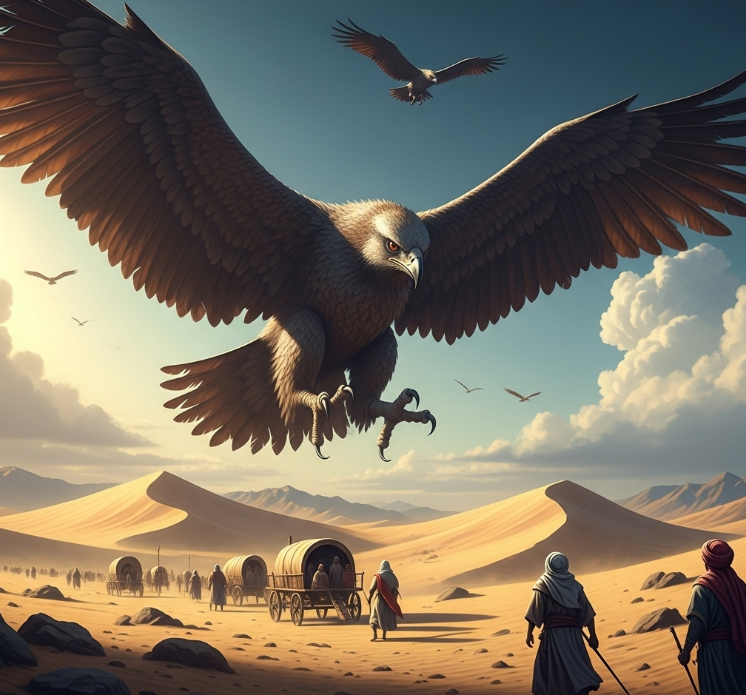From Middle Eastern Mythology to Global Legend
Towering across the skies with wings so vast they could blot out the sun, the Roc (or Rukh) is one of the most awe-inspiring creatures in Middle Eastern mythology. Described as a colossal bird of prey capable of lifting elephants into the air, the Roc's myth has captured the imagination of storytellers, travelers, and readers for centuries.
Rooted in ancient folklore and elevated through Islamic Golden Age literature, especially the Arabian Nights, the Roc has become a lasting symbol of untamed power, mystery, and the surreal wonders of the East.
Origins in Middle Eastern Mythology
The Roc likely has pre-Islamic roots, evolving from Persian, Indian, and Arab oral traditions. Early references to gigantic birds appear in ancient Middle Eastern texts, where they are often associated with divine retribution or supernatural phenomena.
The first major written mention of the Roc appears in the travel writings of Ibn Battuta, the famous 14th-century Moroccan explorer. He describes a giant bird in the Indian Ocean, linking it to the mythical Roc. However, it was through the One Thousand and One Nights (Arabian Nights) that the Roc took its most vivid and lasting form.
The Roc in Arabian Nights
In the Arabian Nights, particularly in the adventures of Sinbad the Sailor, the Roc is depicted as a monstrous bird of almost divine scale. Sinbad, shipwrecked and wandering an uninhabited island, famously ties himself to the Roc’s leg in hopes of escaping—only to be carried to a distant, even more perilous land.
The bird is described in fantastical terms:
Its wingspan is said to be wide enough to eclipse the sun.
It nests on high mountain peaks, unreachable by mortals.
It feeds on giant serpents, elephants, or anything unfortunate enough to cross its path.
These stories didn't just entertain—they inspired awe and fear, representing the unpredictability of nature and the limits of human power.
Symbolism and Meaning
In Middle Eastern lore, the Roc is more than a monstrous bird—it embodies themes of:
Cosmic scale and mystery: Its immense size reflects the vast, unknowable forces of the world.
Divine punishment or justice: In some tales, the Roc is a harbinger of fate or acts as a divine instrument.
Curiosity and hubris: Sinbad’s encounters with the Roc often serve as cautionary tales about the dangers of overreaching or trying to control nature.
The Roc also symbolizes the fantastical unknown, much like dragons in Western mythology or the Garuda in Hindu and Buddhist traditions.
Influence on Later Literature and Culture
The Roc’s legend spread far beyond the Middle East through trade, translation, and the global influence of the Arabian Nights. It deeply impacted:
Medieval and Renaissance Europe
European translations of the Arabian Nights (notably Antoine Galland’s 18th-century French edition) introduced the Roc to Western readers.
Writers like Marco Polo mentioned giant birds they heard about on their travels, blending myth and traveler’s lore.
Modern Fantasy Literature
Roc-inspired creatures appear in the works of J.R.R. Tolkien, Dungeons & Dragons, and Harry Potter (where it resembles the Thunderbird or the Hippogriff).
In video games and fantasy RPGs, giant birds based on the Roc are common boss enemies, representing nature's overpowering might.
Popular Culture
The Roc has appeared in animations (like Sinbad: Legend of the Seven Seas), comics, and even music, maintaining its relevance as a symbol of the exotic and fearsome.
Real-World Inspirations?
Some scholars speculate that the myth of the Roc may have been inspired by real but now-extinct giant birds, such as the Aepyornis (Elephant Bird) of Madagascar or the Haast’s Eagle of New Zealand. Sailors encountering massive bird bones or unfamiliar species might have exaggerated their size over time, feeding the legend.
Additionally, the Garuda of Hindu mythology—a divine eagle-like creature—may have influenced the development of the Roc myth as it passed through cultural exchanges along trade routes.
Conclusion: The Roc as a Mythical Beacon
The Roc remains a powerful figure in global mythology—not just as a massive bird, but as a reminder of the unknown, the sublime, and the limits of human control. Its story bridges East and West, myth and history, fantasy and cautionary tale.
Even today, the Roc soars in the minds of storytellers and readers, inviting us to imagine skies filled with wonders too vast to comprehend—and the courage (or folly) it takes to chase them.







